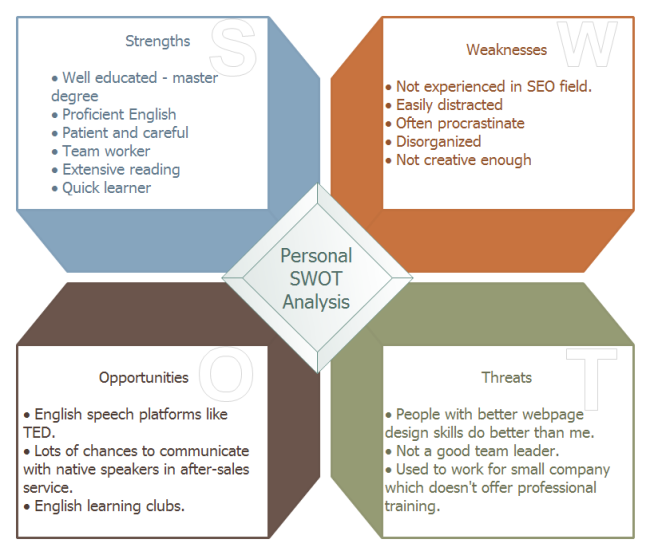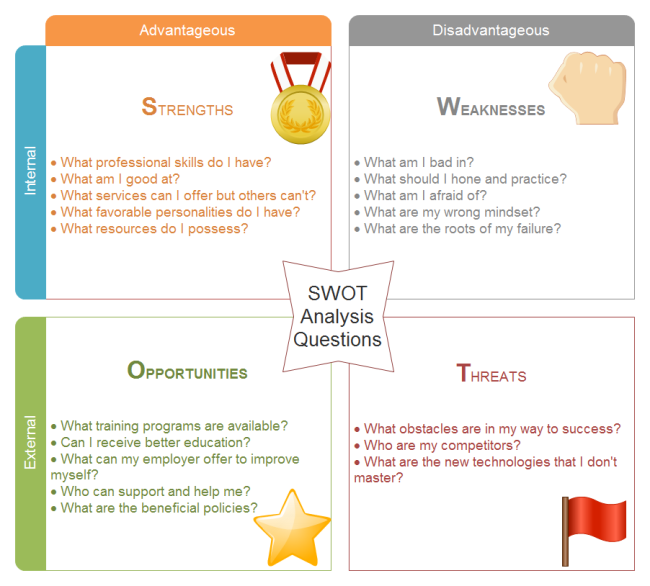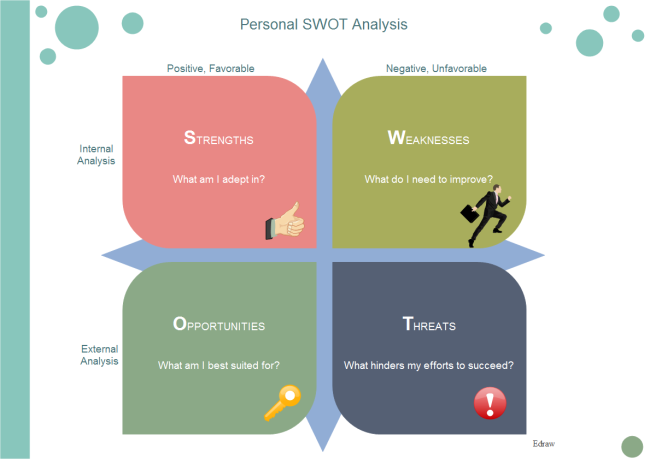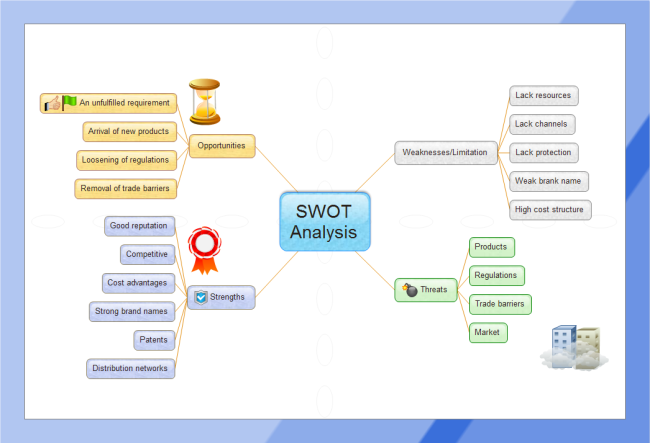A Complete Guide for Personal SWOT Analysis with Examples
If you are looking for a better but also professional way to climb the corporate ladder or looking for a new job, then try using Personal SWOT Analysis. This is an ideal self-assessment method that will help you create a clear scope of yourself.
Furthermore, it is an ideal method since it gives you "true values" that are essential in creating a sustainable growth plan. You can look at the personal swot analysis examples below for a better understanding.
This article is a complete guide for Personal SWOT Analysis with examples that will help you know:
Part 1: What is a Personal SWOT Analysis
Personal swot analysis is an analysis method used to identify or measure personal external (opportunities and threats) and internal (strengths and weaknesses) factors/traits in the business venture. This method is an important exercise that has proven helpful to most individuals thanks to it being a tried-and-true method.
Basically, it helps you identify the following:
- Strengths: The traits that give you an advantage over others.
- Weaknesses: The characteristics that are a disadvantage in relation to others.
- Opportunities: What technologies or trends can you utilize to gain an advantage.
- Threats: The hindrances that hinder your career growth.
Personal swot analysis features a ton of benefits for your career path, so if you want to climb to the pinnacle of the competitive cooperate world. So, why do you need to do a personal SWOT analysis, or what are some of its essential benefits?
Part 2: Why you need to do a personal SWOT analysis
Why use SWOT analysis over other methods? You might be asking yourself this question, hold on, because I got answers for you.
First introduced by Albert Humphrey in the 1960s, this method has since been proven the best method for self-assessments. There are hindered of other personal SWOT analysis methods, but this method still stands out from the rest.
So here are a few reasons that show why:
- Simple to use: This method is one of the simplest SWOT analysis tools that can be used by any person without the need for prior experience or even training.
- Sustainable method: Unlike most methods, swot analysis method has stood the test of time. This is seen in its effectiveness rate, which hasn't really decline since the '60s and '70s.
- Easy to understand: With swot analysis, you can influence decision-making. This is simply because it clearly differentiates between external (opportunities/threats) and internal (strength/weaknesses) factors.
- Multipurpose method: Besides self-assessments, this method can also allow you to assess business competitors and places too. Great right!
These are just the chief benefits. There are many other benefits that come with using SWOT for self-assessment. Now you know what it is and its advantages, let’s now learn how to complete a personal SWOT analysis.
Part 3: How to complete a personal SWOT analysis
Personal SWOT analysis comprises of four key points, which are
Internal Factors
- Strengths
- Weaknesses
External Factors
- Opportunities
- Strengths
Therefore, to complete a personal swot analysis, here are what you need to in each of these factors.
a) List down the Strengths
Highlighting your strengths refers to knowing what characteristics give you an advantage over others. By knowing these traits will definitely help improve your confidence in an interview. So, how do you do this?
NOTE: Don’t be modest.
- What strengths do other people see in you?
- What other traits or skills will make you ideal for that post? i.e., your leadership qualities and great dedication to work
- What type of business contacts do you have? Preferably in fields like insurance, marketing, and advertising.
- Have you completed any campaigns or projects? If so, what are they?
- With your expertise in a certain field, can you impact positive change in an organization?
- What professional certifications or qualifications do you have that make you stand out from the rest?
b) Know your Weaknesses
When filling these sections, ask yourself these questions:
NOTE: Be honest while answering them.
- What traits do you think you should and can improve on?
- What traits have others considered your weakness? Even if you don’t consider them to be.
- Do you have bad habits? If so, what are they? i.e., bad time reporting, poor communication skills, frequently getting late, etc.
- To deliver success in your current or future roles, do you think you have the essential skills or qualifications?
How do these questions help? Mainly it is essential to know your weakness so as to be able to answer or counter some questions in an interview. Furthermore, it helps you improve yourself as an individual because identifying your weaknesses is the best way to improve them.
c) Find “Opportunities”
For this, you will need to find matching opportunities that will suit your skillset.
- What are the areas in which is your industry growing?
- Can technology help you advance your industry reach and development?
- Do you have powerful industry contacts, and how could these connections be of benefit to you?
- What trends in your industry can you take advantage of?
- What new impactful skills can you acquire to boost your skills portfolio?
d) Keep an eye on “threats”
By identifying possible threats that can impact your role in the organization, you can try to eliminate them if possible. Here’s how to identify possible threats:
- Do you have competition? If yes, then who? For example, are you fighting for the same promotion with your peers? -knowing if your peers can do or are doing better in similar roles is an essential thing.
- What obstacles are currently affecting you in your role?
- Will your experience slow your progress due to certifications or new technology demands?
- Can current job and industry changes and progression affect your advancement?
- Can your personal traits hinder your career advancements?
Part 4: Personal SWOT analysis examples
Since you know how and what to include in your personal SWOT analysis, where can you find professional free-to-use templates?
EdrawMax is currently of the best online personal SWOT analysis creator that provides you with a ton of templates to work with alongside its great features support. You can easily create it from scratch or use the available templates. After you are done making it, you can download it. But if you choose to save it online, the saved diagram will easily be accessible.
Here are some examples of the types of SWOT diagrams you should know.
1) Personal SWOT analysis examples
It is a personal SWOT diagram analysis that is used for analyzing an individual's favorable and unfavorable factors for career development. You can make it in a more detailed way by asking questions, as shown in the following example.
Example 1 - 3D Personal SWOT
Example 2 - Personal SWOT Analysis Questions
Example 3 - Simple Personal SWOT Analysis
2) SWOT Analysis Mind Map
This personal SWOT analysis example diagram utilizes mind map design which is still easier to create too. You can add pictures like the ones in opportunities, strengths, and threats to spice up its looks.
Part 5: When to use personal SWOT analysis
By identifying possible threats that can impact your role in the organization, you can try to eliminate them if possible. Here’s how to identify possible threats:
- You are considering a career shift. For example, a shift from software engineer to the marketing field.
- Looking for a promotion
- Setting or starting a new goal or project
Part 6: Conclusion
Overall, personal SWOT analysis offers action steps, laser focus, and great insights into your game.
Therefore, when making a personal SWOT analysis diagram, you will need to console the people you trust and who know you well. For these, you will have to hand them a complete matrix diagram and provide honest feedback after doing a complete review. This will help refine your final copy into a more inclusive and concrete swot analysis table.
This a recipe for success that will help you level up your professional game. So, keep exercising with this every time you when approaching a new goal or project, looking for a promotion or new job, or even when considering a career shift.



